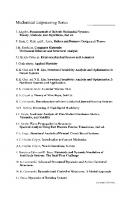Lasers: Theory and Practice (Prentice-Hall International Series in Optoelectronics) 0135214939, 9780135214930
This textbook on lasers is suitable for use in graduate and postgraduate courses. Both the theoretical and practical sid
236 75 78MB
English Pages 520 [491] Year 1995
TAble
FormatFactory PDF Joiner chapter 1+Chapter2,7+CH8_compressed
Recommend Papers

- Author / Uploaded
- John Hawkes
- Ian Latimer
File loading please wait...
Citation preview
Energy levels in atoms and molecules
43
Conduction band Donor levels
Acceptor levels Valence band
Figure 1.25 Position of donor and acceptor energy levels in a semiconductor. The levels arise because of doping with impurities having a valence of one more or less than that of the host.
When an impurity with a valency of one less than the host material is added, empty states are formed just above the top of the valence band into which electrons
can be excited (i.e. they 'accept' electrons, and hence the name acceptors). When
an electron is excited from the valence band into an acceptor state a hole is formed.
Thus doping with acceptors increases the number of holes in the valence band. Problems 1.1
Show that the total energy of an electron moving in a Bohr-type orbit round a fixed positive charge (+e) is given by e
Es
81 EOT
1.2
where the zero of potential energy is at r=º. Show that when the finite mass of the nucleus is taken into account, Eq. (1.9) may still be used to describe the energy of the system provided the electron mass is replaced by
the reduced mass, m., where
11,1 m;
me
mp
Determine the effect this correction has on the emission wavelength of the transition considered in Example 1.1. 1.3
Using the simple Bohr model calculate the second ionization potential of helium and the third ionization potential of lithium (the experimental values are 54.4 eV and 122.4 eV, respectively).
1.4
Show that the operator representing the sum of the squares of x, y and z angular
momenta, LP (where Î? = 12 + 13 + 1;) is given by
-31_12 (since)8). 102_1 [sin(e)ae (sinao) * sin?(0)262]
Show also that the operator L2 commutes with the operators lx, ly and lz, but that the latter three operators do not commute with each other.









